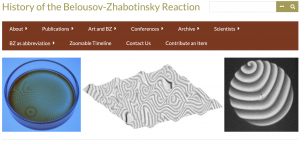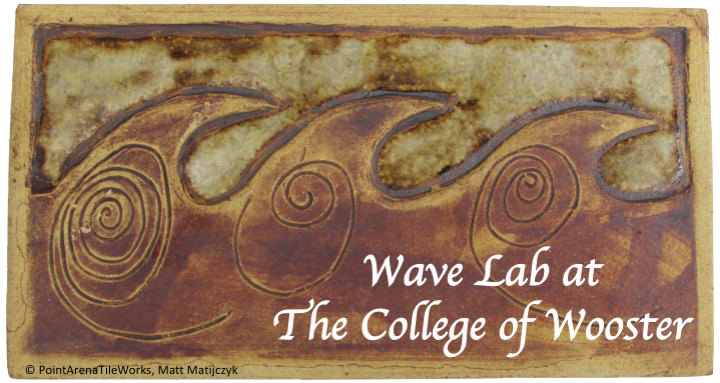The BZ reaction had an interesting beginning because Boris P. Belousov discovered this oscillatory systems but could not publish his results in the early 1950s due to the scientifc belief that chemical reactions can’t oscillate. Anatol M. Zhabotinsky developed the system and was able to publish his results in the early 1960s. Since the 1968 conference in Prague, Czechoslovakia (considered the birth year of the BZ reaction) the BZ system has become the model system to investigate pattern formation in reaction-diffusion systems.
 This long-running project started some years ago and gained momentum after participating in the weeklong workshop by the Institute for Liberal Arts Digital Scholarship (ILiADS) in 2017. This was the starting point of the website, developed using Omeka. We also implementated a zoomable timeline using Time Glider, a web-based time line software. This flexible time-based visualization tool is perfect for displaying our various historical data and information. All digital content (image files, datasets, project documentation, etc.) are preserved by the College’s Digital Curation Librarian, in DuraCloud.
This long-running project started some years ago and gained momentum after participating in the weeklong workshop by the Institute for Liberal Arts Digital Scholarship (ILiADS) in 2017. This was the starting point of the website, developed using Omeka. We also implementated a zoomable timeline using Time Glider, a web-based time line software. This flexible time-based visualization tool is perfect for displaying our various historical data and information. All digital content (image files, datasets, project documentation, etc.) are preserved by the College’s Digital Curation Librarian, in DuraCloud.
Currently, the website “History of the Belousov-Zhabotinsky reaction” contains about 600 items (documents, pictures, and videos) in various exhibitions covering topics such as ‘Art and BZ’, the use of BZ as an abbreviation is other contexts, and most conferences related to the BZ reaction since the first in 1966 in Pushchino near Moscow, USSR (containing never published images). Pages are highly hyperlinked with, for example, a section of books related directly to the BZ reaction but also in the broader field of reaction-diffusion systems and general pattern formation. More than 170 books from 1850 – 2019 can be found in subpages for English, French, German, and Russian publications.
 The long row of names on the right lists people who contributed to the project in various ways. For example, the digital and physical archive contains proceedings of the early conferences, autographed preprints and books, audio and video files, and two of Anatol Zhabotinsky’s lab notebooks.
The long row of names on the right lists people who contributed to the project in various ways. For example, the digital and physical archive contains proceedings of the early conferences, autographed preprints and books, audio and video files, and two of Anatol Zhabotinsky’s lab notebooks.
The second part of the project is a book in collaboration with Richard J. Field, Professor Emeritus at the University in Montana and Konstantin Kiprijanov, a science historian at the Technical University in Berlin, Germany.
Blog entries on our Physics webpage
- 2022, May 23: Science, serendipity, and coincidence
- 2022, January 7: 50 years later
- 2020, March 7: Meeting 100+ years of experience in nonlinear dynamics
NSF-REU Summer research
- Walker Wood ’26 (2024): Translating primary Russian documents
- Isaac Steinmeyer ’25 (2023): Translating primary Russian documents
- Tanaka Chingonzo ’21 (2018): Zoomable timeline of the history of the Belousov-Zhabotinsky reaction
- Mirkamil Mijiti ’19 (2017): The Belousov-Zhabotinsky History Website Creation
Student Research Experiences during the academic year
- Isaac Steinmeyer ’25 (2024SP)
- Natalie Miller ’25 (2023SP)
- Dennis Bolshakov ’19 (2018SP)
- Tanaka Chingonzo ’21 (2018FA – 2019FA)
- Daniel Dorman ’20 (2017FA)
- Daniel Halbing ’21 (2019FA – 2020SP)
- Daphne Letherer ’20 (2020SP)
- Mirkamil Mijiti ’19 (2017SP)
- Lubov Sidorova (2018FA – 2019SP)
Poster presentations
- N. Manz (2022) “Evolution towards the now accepted name Belousov–Zhabotinsky reaction”, Gordon Research Conference on Oscillations and Dynamic Instabilities in Chemical Systems, Stonehill College, Easton, MA, USA, 2022 July 17-22
- N. Manz, R. J. Field, and K. Kiprijanov (2016) “Illustrative timeline of Boris P. Belousov and Anatol M. Zhabotinsky”, Gordon Research Conference on Oscillations and Dynamic Instabilities in Chemical Systems, Stowe, VT, USA, 2016 July 17-23
Publications (click for more info)
- R. J. Field, R. M. Mazo, and N. Manz
Science, serendipity, coincidence, and the Oregonator at the University of Oregon, 1969-1974
Chaos: An Interdisciplinary Journal of Nonlinear Science 32 (2022), 052101. (DOI)- Web article in the Wooster News.
